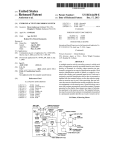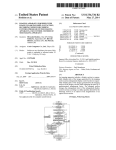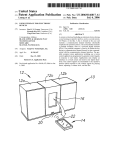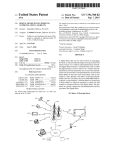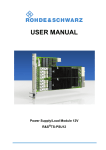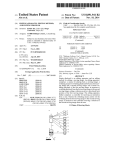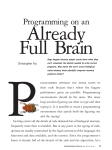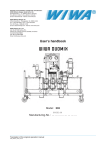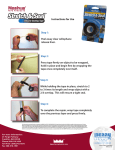Download Exercise activity recording system
Transcript
US 20140074264A1 (19) United States (12) Patent Application Publication (10) Pub. No.: US 2014/0074264 A1 (43) Pub. Date: Anderson et al. (54) EXERCISE ACTIVITY RECORDING SYSTEM (52) Mar. 13, 2014 us. c1. CPC ................................ .. A63B 24/0075 (2013.01) (71) ApplicantszBrent Anderson, Kirkland, WA (US); USPC .......................................................... .. 700/91 Douglas E. Nichols, Redmond, WA (US) (72) Inventors: Brent Anderson, Kirkland, WA (US); Douglas E. Nichols, Redmond, WA (US) (21) App1.No.: 14/082,020 (22) Filed: Continuation of application No. 13/452,812, ?led on Apr. 20, 2012, noW Pat. No. R,E44,650, Which is an application for the reissue of Pat. No. 7,699,752, Which is a continuation-in-part of application No. 10/819, 052, ?led on Apr. 6, 2004, noW Pat. No. 7,507,183. (60) Provisional application No. 60/461,204, ?led on Apr. 7, 2003. piece of equipment, exercise movement exercise area, ?tness activity or biometric in a facility Where exercises are pre formed is assigned to an exercise identi?cation module. Each exercise identi?cation module is linked or coupled to a ter minal With a display and a manual input device. Each user is assigned a personal identi?cation device that is presented or inputted into the terminal before or after the exercise equip ment or exercise area is used. After exercising, the user acti vates the exercise identi?cation module assigned to the exer cise equipment or to the exercise area. Upon activation, one or more sub -routines automatically run in the terminal. Prompts Publication Classi?cation (51) ABSTRACT A multiple exercise activity recording system in Which each Nov. 15, 2013 Related US. Application Data (63) (57) tion may be stored in the terminal or immediately transmitted Int. Cl. A63B 24/00 presented on the display then request user input of informa tion pertinent to the exercise activity. The inputted informa (2006.01) to a permanent member data ?le on a local or remote server. Patent Application Publication Mar. 13, 2014 Sheet 2 0f 6 US 2014/0074264 A1 Patent Application Publication Mar. 13, 2014 Sheet 3 0f 6 .15 US 2014/0074264 A1 Patent Application Publication Mar. 13, 2014 Sheet 4 0f 6 US 2014/0074264 A1 Patent Application Publication Mar. 13, 2014 Sheet 5 0f 6 US 2014/0074264 A1 mm»a ham: H w.mwfxm 1% mawma,im2é %w“ g WWW Mwam ?mx Patent Application Publication Mar. 13, 2014 Sheet 6 0f 6 US 2014/0074264 A1 $m3 3 "v1$.3 .3. 1/)shi1?V Sm i: , ZmMw mw Mar. 13, 2014 US 2014/0074264 A1 EXERCISE ACTIVITY RECORDING SYSTEM [0001] This utility patent application is a continuation in part application of the US. Pat. No. 7,507,183, issue date [0008] TWo basic approaches have been attempted toWard the goal of recording exercise activity onto a digital medium: “active netWork systems” and “scripted training systems.” is based on the provisional patent application (Ser. No. 60/461,204) ?led on Apr. 7, 2003. [0009] Active netWork systems deploy a local electronic netWork in the health club With each exercise machine equipped With a display monitor, data input means and sen sors, and operating as a data collection node. The health club BACKGROUND OF THE INVENTION member identi?es himself or herself to a particular machine or Workout station via entry of a personal identi?cation num Mar. 24, 2009, (Ser. No. 10/819,052), ?ledApr. 6, 2004 Which [0002] 1. Field of the Invention [0003] This invention relates to exercise metrics recording systems, and more particularly, to exercise metrics recording systems located in health club/ gym facilities that offer differ ent pieces of exercise equipment and exercise activities to its members. [0004] 2. Description of the Related Art [0005] There are approximately 22 thousand ?tness centers and health clubs in the United States serving approximately 40 million members. The health club industry is characterized ber on a key pad at the Workout station. Upon completion of the exercise, certain performance information collected by sensors at the Workout station is transmitted to a central server Where individual exercise records are stored. Active netWork systems are effective Where exercise equipment operates at a ?xed location in the gym or ?tness center, and Where each piece of exercise equipment in the netWork supports only one or tWo exercise movements. [0010] Active netWork systems encounter problems deal ing With any equipment that is mobile or capable of being employed in multiplicities of exercise movements. Free Weights are the most obvious example of exercise equipment by rapid groWth in club members (8% per annum) and an explosion in exercise related activities and equipment. There that cannot be linked in an active netWork system. In addition has also been tremendous groWth in information related to the optimal use of exercise equipment including: the best use of to problems accommodating data input from some types of exercise equipment, active netWork systems do not support time devoted to exercise, long term impact of speci?c exercise activity, avoidance of injury, and preferred combinations of tracking of activity-related exercise (e.g., aerobic dancing; running; basketball; etc). Additionally, the provisioning of exercises. electrical poWer to active netWorked systems and the instal lation of netWork monitors, data input means, and sensors at [0006] To help individual health club members maximiZe the bene?t of time spent exercising, most health clubs offer professional training services. Professional training services support the goals of maximiZing the bene?t of time expended toWard exercise, injury avoidance, and maintaining a long each piece of the netWorked equipment result in high capital installation costs and high recurring maintenance costs. services (as currently offered) require the trainer to directly Active netWork systems are also costly to expand as neW exercise machines and methods are brought into the health club. [0011] The second means to record exercise-related activ participate in his or her clients’ exercise sessions to observe ity involves the use of dedicated softWare programs operating term focus to a given exercise regime. Professional training and track activity and performance. Direct participation by on PDAs or similar handheld devices. Exercise softWare pro the professional trainer in most or all of his or her clients’ exercise sessions carries With it a number of negative grams fall into tWo categories: “menu-driven database pro grams” and “scripted exercise routine systems.” attributes, including very high service costs, advance sched uling requirements for exercise sessions, regimentation of [0012] Exercise menu-driven programs involve simple database lookup programs applied to the tracking of ?tness recreational Workout activity into ‘hard core’ training ses sions and, for some, a ‘loss of privacy’ in exercise activity that many health club members vieW negatively. club member scrolls through a preprogrammed menu of com monly available exercises, identi?es his or her intended exer [0007] An effective exercise metrics recording system enabling individuals to independently record their exercise activity in a digital format Would permit ?tness professionals to effectively counsel and/ or train the individual system mem ber Without necessitating the trainer’s direct participation in each of the client’s day to day Workouts. Such an exercise metrics recording system Would also eliminate advance scheduling and aesthetic problems associated With the use of professional training services. Most important, such an exer cise metrics recording system Would permit professional counseling services to be rendered more e?iciently at prevail ing price levels, and enable health clubs to provide a much broader range of ?tness training/counseling services to address the needs and price constraints of the majority of health club members. Finally, the digital exercise and ?tness records produced by such an exercise metrics recording sys tem could be provided to third parties not a?iliated With the health club or ?tness center, such as doctors, therapists, man aged healthcare providers, corporate Wellness program activity. Using a PDA or similar handheld device, the health cise activity, and enters certain performance information into the handheld device upon completion of the exercise. The principal problem With menu-driven database programs as applied to health and ?tness records is the length and com plexity of the menu necessary to accommodate the literally thousands of exercise options available in a typical health club. The burden of cycling through available Workout options to locate the desired entry point in the database pro gram has rendered menu-driven database programs too bur densome for most health club members and impractical as effective exercise metrics tracking systems. US. Pat. Nos. 4,493,485; 4,409,992; 4,408,183; and 5,890,997. [0013] Scripted exercise records systems exist in multiple forms. In their simplest embodiment, a piece of paper can be carried through a Work out With an exercise program Written on it, as the User folloWs the prescribed routine he/ she checks boxes and Writes doWn performance data. Systems have been developed to simplify the task of data entry and data conver administrators, etc., Who have an interest in the health and sion into a digital format by introducing a PDA or similar handheld device con?gured to store user exercise perfor Well-being of particular health club members. mance data relative to an exercise script Which is carried on Mar. 13, 2014 US 2014/0074264 Al the PDA like device or recorded on a Work out card to be read by the PDA. There are many number of innovations relative to ?tness facilities Which offers different pieces of exercise equipment and exercise activities to its members. [0017] It is another object of the present invention to pro script based exercise records systems, but the identi?cation of these script based exercise record systems as “related art” is vide such a system that uses handheld devices or terminals problematic. Scripted systems simply do not meet the chal that alloW members to easily record various exercise activities lenge of identifying What exercise activity/ s a User elected to perform during a given Work out. Rather than address the multiple thousands of combinations related exercise data in the facility. source, and possible combinations of Weight used, repetitions completed, time, distance, speed, resistance level etc., [0018] It is another object of the present invention to pro vide such a system that provides exercise machine or exercise activity related sub-routines to the member that instructs the scripted systems alloW the User to record performance member regarding the type of data to be inputted into the handheld device to terminal by the member after the exercise against a narroWly de?ned exercise program. The user per is completed. forms the prescribed exercise and then records certain perfor systems represent a fundamental difference relative to the [0019] It is another object of the present invention to pro vide such a system that alloWs health club trainers the option to selectively program the handheld device or terminal for speci?c members instructing the members to include or more speci?c types of exercise and the exercise level to be pre subject invention and other “related art” described herein. formed on those recommended exercises. Script-based exercise systems necessarily require members [0020] It is another object of the present invention to pro vide such a system that is relatively inexpensive to assemble, install and maintain. [0021] It is another object of the present invention to pro mance information by hand or into a PDA or similar handheld device Which contains the exercise script. The limitations placed on data input sources by script based exercise records to strictly folloW a prescribed training program in order to track performance. While most health club members folloW generaliZed patterns in their exercise and recreation The majority of health club members do not strictly folloW train ing programs, (The average health club member being over nals that are uniquely con?gured and provided by the health 30 years old and more interested in maintaining a reasonable club for use in the health club. level of ?tness than running a marathon or “body sculpting”. [0022] It is another object of the present invention to pro vide such a system that does not require the direct participa Accordingly, script-based systems have enjoyed limited acceptance among health club members. Finally, While Script based systems are not precisely “related art,” a second issue is Worth noting that has kept these systems from enjoying Wide applications in the health and ?tness club market. [0014] An exercise script for a PDA can be Written by anyone for use by a health club member in the gym. While the health club operator can control perimeter facility access, the health club operator cannot control access to individual exer cise apparatus or compel the use of his or her club based training services in conjunction With the script based system. In fact, script based exercise records systems operate to intro duce internet/non resident trainer competition into a health club, threatening a major revenue source for the typical health club. The end result being relegation of script based systems to treatment related exercise programs (Health care provider prescribed) and limited acceptance by inteme trainers. [0015] A need exists for a neW exercise metrics collection system for a health club capable of collecting, transferring, storing, and managing individual exercise records of its mem bers, Without the operating restrictions and high costs described herein above. The neW system Will differ from existing methods, offering its members easy and ?exible operation unencumbered by scripted exercise routines Which are directive in nature. Such a system should accept data input from any ?tness data source including activity-based Work outs (e.g., aerobic dancing; running; basketball; etc.), stretch ing, all forms of resistance training (including exercises using free-Weights), and biometric monitoring devices. In addition system should be materially less expensive to install and maintain than are active netWork systems, and must provide for control over access to the system, particularly its exercise identi?cation component SUMMARY OF THE INVENTION [0016] It is an object of the present invention to provide an vide such a system that uses only handheld devices or termi tion of a trainer during or after every exercise session. [0023] It is another object of the present invention to pro vide such a system that does not require a member to perform exercise activity according to a prescribed sequence. [0024] It is another object of the present invention to pro vide such a system that can be linked to other health clubs so that members’ exercise records may be aggregated and quan titatively or qualitatively evaluated, and shared. [0025] It is another object of the present invention to pro vide such a system that can centrally store, protect and dis cretely distribute individual exercise records in such a Way as to alloW individual records to address member exercise activ ity preformed aWay from the member’ s home gym and further to alloW for the distribution of individual exercise records to interested and authorized third parties (healthcare providers, Weight loss clinics, insurance providers, DoD [force readi ness] Etc.) [0026] It is another object of the present invention to pro vide such a system that can deploy statistical analysis and data base tools against a centrally stored collection of, individual exercise records to provide business and public interest related data mining against the system’s population of indi vidual records. [0027] It is another object of the present invention to pro vide such a system that deploys softWare tools Which apply statistical analysis and ?tness related information/principles against an individual’s exercise records to aid in maintaining safe and effective exercise patterns. [0028] These objects are met by an exercise activity records system disclosed herein that enables users to easily record different exercise activities performed in the facility. In a ?rst embodiment, the system includes a portable handheld device capable of being pre-programmed by the trainer for a speci?c member that is then used by the member to record exercise activities. The system also includes a unique identifying inexpensive, easy to use exercise recording system speci? “exercise identi?cation module”, hereinafter referred to as an cally designed for use in a health club and other sports and EIDM, attached to or located in the proximate vicinity of an Mar. 13, 2014 US 2014/0074264 A1 exercise activity source. The handheld device includes a dis are then presented on the terminal’s display. The user then play monitor, a data input means, and an EIDM interrogation manually inputs exercise speci?c information into the termi means used query the EIDM. During use, the member acti nal in response to the prompts. vates the handheld device Which executes an exercise data [0032] The key differences betWeen the ?rst and second embodiments, is that mobile and ?xed components of the system are reversed. In the ?rst embodiment, after the EIDM is activated, a data exchange sequence is initiated by the collection software program loaded into the Working memory of the handheld device. When the member selects a piece of exercise equipment or an exercise activity, (eg Weight lift ing), the EIDM interrogation means is activated and used to interrogate the EIDM. When the EIDM is identi?ed, the exer cise data collection softWare program automatically executes a software sub-routine speci?cally designed for the indi vidual and the speci?c exercise activity source associated With the EIDM. More speci?cally, the sub-routine presents a data entry page on the display monitor. The data entry page identi?es the exercise machine or activity, the type of exercise to be completed, and presents a plurality of prompts request ing speci?c information from the member regarding the exer cise activity performed on the exercise activity data source. The information that is inputted into the handheld device using the input means is directly stored in a temporary mem ber data ?le on the handheld device or transmitted directly to a permanent member ?le stored on a local server located in the health club. If the information is stored in a temporary member data ?le on the handheld, it is later uploaded to the local server. Each time the member moves to a neW exercise data activity source, the EIDM interrogation means and the EIDM are used to quickly identify the exercise activity data source and present the proper sub-routine associated With the exercise activity. [0029] In another embodiment of the invention, the exer cise activity source in the facility Where exercises are pre formed is assigned to an EIDM but each EIDM is linked or coupled to a stationary terminal connected to or located near the exercise activity source. The terminal, Which may be linked exclusively to one exclusively exercise activity source and one EIDM or may be linked to multiple exercise activity sources and EIDMs, is connected to a display and an optional manual input device. The EIDM associated With each exer cise activity source may be located at or near the exercise activity source or it may be mounted on the terminal’s front handheld. In the second embodiment, When the user activates the EIDM, a data exchange sequence is initiated in the termi nal. In both embodiments, a sub-routine speci?c to the exer cise activity source is automatically generated. In the second embodiment, the identi?cation sequence is directed toWards identifying the user to the terminal and to the speci?c exercise selected by the system user. The EIDM is noW in a ?xed location as are the terminal With the exercise date program, the exercise speci?c sub-routines and the processor. The only mobile component is the user’s identi?cation codes or input device. Also, inputted information may be stored in the ter minal or immediately transmitted to a permanent member data ?le on a local or remote server [0033] In both embodiments, the system may includes a local server located in the facility With permanent member data ?les that contains the inputted records from the handheld devices or terminals used by members in the club. In another embodiment, the local server is replaced by an uplink termi nal connected to a remote server located in a netWork opera tions center, hereinafter referred to as a NOC, that via the Internet. In both embodiments, a data base softWare program designed to collect the uploaded records in the handheld device’s or terminal’s temporary member data ?le and then present the information to the trainer and/or member When connected to the server. [0034] The system Will also use a tool set of softWare pro grams, hereinafter referred to as a ‘tool set’, Which support data colorations unique to exercise metrics and associated directly or indirectly to the member’s speci?c Workout his tory. The system Will cross track and display to the health and, ?tness professional any number of relationships and data correlations to the member’s Work outs. In addition, the tool set Will maintain and display state of the art information to panel or on a multiple exercise activity demonstration board. Loaded into the memory of the terminal is an exercise data collection softWare program and user data ?le. [0030] Each user is assigned a personal identi?cation code Which must be manually inputted into the terminal or assigned an electronic identi?cation device that interfaces ?tness professional counseling the member identifying areas of concern/progress and offering alternative course of action (in terms of exercise) to effectively counsel the member rela tive to his/her exercise regime. With the EIDM or another compatible input device to input the user’ s identi?cation into the terminal. The personal iden recording the exercise routines in a health club, an exercise ti?cation code or electronic identi?cation device transmits the user’s identi?cation information to the terminal before or after the exercise equipment or exercise area is used. An example of an electronic identi?cation device assigned to a user is an I-button. During use, the user’s I-button is pressed against a compatible, terminal linked I-button connected or member selects a health club or facility With different exercise activity data sources each associated With a unique EIDM. When the member visits the health club or facility, he or she may be provided a handheld device as describe above loaded With various softWare sub-routines associated With the linked to the terminal that automatically transmits the user’s Which, When activated by the user’s I-button, automatically throughout the health club or facility, he or she performs various exercise activities, and inputs data in response to the sub-routine prompts. When the exercise activity is com pleted, the temporary member data ?le on the handheld informs the terminal Which exercise activity source is selected and also informs the terminal of the user’s identi? cation information. [0031] After exercising, the user activates the EIDM asso ciated With the exercise activity source. When the EIDM is activated, a sub-routines and prompts relating to the exercise device or terminal is uploaded to the local server or to the remote server on the NOC. The ?tness data base softWare program on the local server or remote server is then used by the trainer to revieW a member’s data ?le. The tool set pro vides the trainer access to the most recent information relative that members exercise needs as Well as a backup to the train personal identi?cation code into the terminal. In the preferred embodiment, the terminal I-button also acts as an EIDM, [0035] Using the above-described device, a method of facility or medical facility is also provided. During use, the EIDMs or a user identi?cation code. As the member moves Mar. 13, 2014 US 2014/0074264 A1 er’ s oWn record review insuring that all areas of concern have been identi?ed and addressed by the trainer relative to the member. [0036] The subject invention deployed an architecture capable of other embodiments and of being practiced and carried out in various Ways. Also, it is to be understood that the phraseology and terminology employed herein are for the purpose of descriptions and should not be regarded as limiting Which is unique and novel relative to the collection of indi DESCRIPTION OF THE DRAWINGS vidual Workout information in a health club environment. [0037] Unlike the prior art active netWork systems identi ?ed herein, the subject invention deploys a handheld or a terminal to collect individual exercise records With this step the subject invention becomes an order of magnitude cheaper than active netWork systems. With the elimination of the active netWork approach the subject invention becomes far more ?exible in its operation, allowing the system to break aWay from ?xed machine limitations of active netWork sys tems to embrace free Weights, basketball, running, handball etc. (and activity Which can be expressed as a numeric. [0038] Deployment of a handheld or a terminal in the sys tem together With an EIDM With Which the handheld or terminal shares a relationship and the location of that EIDM on or around its represented exercise activity source alloWs the user to gather data from anyWhere in the health club or facility any time in any order. In this manner, the invention is not con?ned to a scripted Workout and alloWs him/her to [0043] FIG. 1 is an illustration of the health club exercise recording system. [0044] FIG. 2 is a perspective vieW of the handheld device being used to interrogate an EIDM. [0045] FIG. 3 is a front plan vieW of the handheld device. [0046] FIG. 4 is a rear plan vieW of the handheld device. [0047] FIG. 5 is a block diagram of the handheld device. [0048] FIG. 6 is an illustration of an exercise data page shoWn on the display monitor. [0049] FIG. 7 is an illustration of various exercise equip ment shoWing different sub-routines executed to display dif ferent exercise data pages to the member. [0050] FIG. 8 is an illustration of the second embodiment of the exercise activity recording system. DESCRIPTION OF THE PREFERRED simply approach and query the EIDM for the exercise EMBODIMENT (s) intended rather than run through multiple menus or fumble through a phone book of optical symbol tag/RFID tags to tell the data collection device What exercise the member intends to do next to further the subject invention. [0039] By using unique identi?ers relative to each exercise activity source at a speci?c site, and by providing an [0051] Referring to the accompanying FIGS. 1-8, there is shoWn a system 10 for easily recording the exercise activities performed With or Without exercise equipment that does not require the direct participation of a trainer. The system includes a portable handheld device 15 used to input exercise “encrypted” response/disclosure capability for each EIDM, information that is uploaded to a local server 95. A ?tness access to the system becomes controllable. The subject inven tools softWare program 50 loaded into the Working memory of the local server 95 is used to collect the uploaded records tion becomes potentially pro?table to the health club there fore available to members in a health club environment. [0040] The over aching structure deployed in the subject invention for the transfer handling of data related to indi vidual Workout records insures, (via database softWare and the tool set that the gym members records are made available to ?tness professionals at the gym and that via tool set/ ?tness professional combination the member receives stat of the art counseling services. Beyond counseling applications the sub ject inventions netWork structure, user authentication func tions and records capability Will alloW individual ?tness records to be made available to authorized and interested third parties. In addition the cumulative data base of member user activity and preferences developed for via the system can be “mined” as a data resource for both public and private sector interests. [0041] Lastly, and a the core of the subject invention is a simple easy to use, installable system Which provides the means to break the requirement for gym based ?tness profes from the handheld device 15 and store them in a permanent member data ?le 52. The member or authorized individuals can then use the ?tness tools softWare program 50 to revieW the member data ?les to determine the member’s ?tness or training levels. [0052] The handheld device 15 is lightWeight, portable, and ruggediZed to make it shock, heat, and moisture tolerant. Loaded into the memory of the handheld device 15 is an exercise data collection softWare program 35 that activates a built-in exercise identi?cation module interrogation means, referred to as an EIDM interrogation means used to detect a unique EIDM attached to or located in the vicinity of the exercise activity data source. When the EIDM is interrogated, the exercise data collection softWare program 35 automati cally executes a sub-routine 80-85 designed for the speci?c exercise activity data source 10 Which sub-routine includes a date/ clock function that automatically records start and stop sional to participate in every member Workout in order to times and the elapsed time for the exercise, as Well as rest intervals betWeen exercises. The sub-routine 80-85 presents effectively counsel that member. [0042] Numerous objects, features and advantages of the present invention Will be readily apparent to those of ordinary prompts 61 displayed thereon each designed to sequentially elicit information manually inputted by the member into the skill in the art upon a reading of the folloWing detailed handheld device 15. The exercise information is then stored in description of presently preferred, but nonetheless illustra a temporary member data ?le 37 on the handheld device 15 that later is uploaded to a local server 95 via an uplink termi nal, a Wireless communication link or a hardWire connection. Each time the member moves to a neW exercise activity data source 10, the EIDM interrogation means and EIDM are used tive, embodiments of the present invention When taken in conjunction With the accompanying draWings. In this respect, before explaining the current embodiment of the invention in detail, it is to be understood that the invention is not limited in its application to the details of construction and to the arrangements of the components set forth in the folloWing description or illustrated in the draWings. The invention is one or more data entry pages 60A-60F With a plurality of to quickly identify the exercise activity data source 10 and present the proper exercise data entry page 60 and prompts 61 associated thereWith. Mar. 13, 2014 US 2014/0074264 A1 [0053] The exercise data collection software program 37 automatically executes the speci?c sub-routine 80-85 associ optional display monitor brightness sWitch 23. Mounted on ated With an identi?ed exercise activity data source 10A-10E the front surface 16 is a function key 24 and an optical reader (see FIG. 7). The exercise activity data source 10 may include activation button 21. Also, mounted on a side 17 or front surfaces 17 of the device 15 are a poWer sWitch 22 and an a treadmill 10A, a stair machine 10B, an elliptical machine surface 16 is a small speaker (not shoWn) to provide audible 10C, free Weights 10D, or a Weight machine 10E With a single cues to a member, such as a cadence tone during certain exercises. Mounted on the rear surface 19 is an optional belt or a plurality of Weight stations as shoWn in FIG. 7. The exercise activity data source 10 may also be a Weight lifting clip or hook and loop connector pads (not shoWn). In other station, a basketball court, an aerobic exercise room, a stretch ing mat or room, a jump rope, a heart rate monitor, a blood embodiments, a biometric security means, such as a ?nger pressure monitor, etc. (not shoWn). When the exercise activity data source 10 is recogniZed, the exercise data collection softWare program 35 automatically presents the exercise data page 60 that presents a plurality of prompts 61 suitable for the exercise activity data source 10. [0054] The EIDM interrogation means and EIDM provide a communication link betWeen the handheld device and the exercise equipment. In the preferred embodiment, the EIDM interrogation utiliZes an EIDM comprised of a computer chip, a chip housing (“can”), a pictorial representation of the exer cise or activity Which the subject EIDM is associated With and a “reader/receiver” incorporated Within the handheld capable of poWering and communicating With the EIDM via a physi cal contact “1 -Wire protocol” data exchange link. The EIDM print reader 25, may be included to prohibit inadvertent use of the handheld device by another member during the course of the exercise session. Also, mounted inside the device 15 is an optional Wireless transmitter 27 enabling the device 15 to communicate With a Wireless receiver 32 connected to the local server 95. The handheld device 15 may also include an optional netWork connection port 33 enabling the device 15 to communicate directly With the local server 95 or to the uplink terminal. [0058] During use, the member activates the handheld device 15 and holds the optical reader 30 to read the ID tag 40 to interrogate and identify the ?tness exercise activity data source 10. Once the ?tness exercise activity data source 10 is present the information in the permanent member data ?le 52 identi?ed, the exercise activity collection data softWare pro gram 35, loaded into the handheld device’s Working memory, automatically auto-con?gures the device 15 and presents the proper exercise data page 60 for the ?tness exercise activity data source 10. A representative exercise data sheet, shoWn in FIG. 6, is then presented on the display monitor 25. [0059] On the exercise data page 60 is shoWn a plurality of prompts 61 that the member responds to after completion of the exercise activity. When the exercise activity is completed, the member manually inputs the data using the keys 26. The inputted exercise activity information is then stored in the temporary member ?le 37 for later uploading to the central to the member or authorized individuals. In a second embodi server 95. ment of the system, shoWn in FIG. 2, the local server 95 is replaced by an uplink terminal that connects to a remote [0060] As more clearly shoWn in FIG. 7, each exercise activity data source (10A-10E shoWn) is assigned a sub server located in or connected to a netWork operations center, NOC. routine 80-84 that presents a speci?c exercise data page 60 A-E to the display monitor 25. The nature of the prompts 61 [0056] The NetWork Operations Center (NOC) provides a central repository for the system’s data base. In addition, the may be the same or different. With some exercise equipment or activity, a second sub-routine 85 and a second speci?c NOC provides a WAN presence to provide records access for exercise data sheet 60F are presented. [0061] The permanent member data ?le 55 provides a com prehensive record of his or her cumulative exercise activity and achieved ?tness level. This ?le 55 can then be evaluated is a compatible ID tag 40, such as a printed identi?cation label/hieroglyph, a radio transducer, or barcodes capable of being detected or interrogated by the EIDM interrogation means. [0055] The local server 95 is designed to receive uploaded temporary member data ?les 37 from the handheld device 15, use the ?tness tools softWare program 50 to collect and store the member ?les in permanent member data ?le 52, and then use the ?tness tools software program 50 to evaluate and club based ?tness professionals Working With the system’s users. The NOC also provides the WAN presence by Which User records input can be made from sources outside of the gym (from home or “on the road”). The NOC also provides system updates, billing as Well as netWork security and docu ment security functions these functions enable delivery of individual exercise records or WAN records access to autho riZed third parties With and interest in individual or group exercise records, including but not limited to: treating physi cians, rehabilitation, therapy professionals, NCAA and other athletic interests, Dept of Defense (eg national guard force readiness, corporate Wellness incentive programs [0057] As shoWn in FIG. 3, the handheld device 15 includes and revieWed by club-based ?tness professionals to provide a broad range of counseling services to members, and the record can be provided to medical professionals or other third parties aWay from the ?tness center Who may have legitimate interests in the ?tness level of any particular member. [0062] In another embodiment of the invention, shoWn in FIG. 8, each piece of equipment, exercise movement area, ?tness activity or biometric equipment (called exercise activ ity source 10) in a facility Where exercises are preformed is assigned to an EIDM. Each EIDM is linked or coupled to a stationary terminal 120 connected to or located near the exer cise activity source 10. The terminal 120 is coupled to a a display monitor 25 and an input means. In the preferred embodiment, the input means is a set often numerical keys 26 located on the front surface 16 of the device 15. In other embodiments, the input means could be a combination moni display 122 and a manual input device 124. Terminal 120 may be used exclusively With one piece of exercise activity source tor and “touch screen” functionality (not shoWn) With the ten numerical keys displayed thereon. Mounted inside the device 10 or With a plurality of exercise activity sources. The EIDM associated With each exercise activity source 10 may be 15 are batteries 28 (AA, AAA or 9 Volt) designed to supply a DC electric current. Mounted on the front surface 16 of the device is an “Identi?cation” button 21. Mounted on the side located at or near the exercise activity source 10 or it may be mounted on the terrninal’s front panel or on a single or mul tiple exercise activity demonstration board 130. Loaded into Mar. 13, 2014 US 2014/0074264 Al the memory of the terminal 120 is an exercise data collection software program 35 and a temporary data user ?le 37. [0072] Increases or decreases in muscle strength, ?ex ibility or endurance [0063] Each user is assigned a personal identi?cation code 140 Which must be manually inputted into the terminal 120 or assigned a portable user identi?cation device 150 that inter faces either directly With the EIDM coupled to the exercise [0073] Allocation of repetitions betWeen muscle groups; [0074] Changes in time of day for Workout, Work out duration, rest time betWeen individual exercises; and, [0075] Changes is any of the forgoing as they relate to activity source or to the terminal 120, or With a compatible terminal based user identi?cation device 155 attached to linked to the terminal 120. modi?cations in Work out activity as a result of an event recorded by the User into the system or as the result of a [0064] The user identi?cation device 140 contains the user’ s identi?cation information 132 that must be transmitted to the terminal 120. The terminal 120 then uses the user identi?cation information to determine the user ?le in Which to temporarily store the exercise data. The user identi?cation information 132 may be inputted or transmitted to the termi nal 120 before or after the exercise activity source is used. [0065] An example of a user identi?cation device 140 assigned to a user is an I-button designed to communicate With a terminal linked I-button. During use, the user’s I-but ton is pressed against the terminal linked I-button and auto ?tness professional’s input to the User by Way of pre ferred changes to the Users Work out regime. [0076] The system Tool Will revieW User health and ?tness activity and performance against “norms” for his/her age sex, time in the gym, Etc. Tools Will high light “trouble areas” identi?ed by this analysis and offer the ?tness counselor input as to possible changes to the Users exercise activity. [0077] The system tool Will revieW User health and ?tness activity and performance against inputs to the Users personal exercise record by health healthcare professionals, therapists etc. and display areas of concern or interest unique to that speci?c user. matically transmits the user’s personal identi?cation code into the terminal 120. In the preferred embodiment, the ter System Operation minal I-button is also linked to a speci?c exercise activity [0078] source so that it also acts as an EIDM, Which, When activated tem using the ?rst embodiment of the system that uses an exercise identi?cation module interrogation means and the EIDM as an optical reader 30 and ID tag 40, respectively. It by the user’s I-button, simultaneously informs the terminal 120 Which exercise activity source is selected and identi?es The folloWing operating scenario describes the sys the user to the terminal 120. should be understood, hoWever, that the optical reader 30 and [0066] ID tag 40 could be replaced With a radio frequency or infrared transmitter and receiver or other Wireless or physical contact/ In the terminal based embodiment, When the EIDM is activated, a sub-routine and one or more prompts relating to the exercise activity source are then presented on the termi nal’s display. The user then manually inputs the exercise performance information into a manual input device 150 coupled to the terminal 120 in response to the prompts. [0067] In this embodiment, the mobile and ?xed compo nents of the system are reversed With respect to the ?rst embodiment described above. When the user activates the EIDM, a data exchange sequence is initiated in the terminal Which initiates a user input identi?cation exchange and a sub-routine speci?c to the exercise activity source. The iden ti?cation sequence is directed toWards identifying the system user to the terminal and to the speci?c exercise selected by the system user. The EIDM is noW in a ?xed location as are the terminal 120 With the exercise data program, the exercise speci?c sub-routines and the processor. The only mobile component is the user’s electronic identi?cation device. Also, inputted information may be stored in the terminal 120 or immediately transmitted to a permanent member data ?le on a local or remote server. [0068] In both embodiments, the complete member records generated by system in combination With a centraliZed data base for the system’s records storage and records access support the development and application of a set of softWare tools Which Will be regularly update With the most current ?tness information. The tool set is directed toWard providing the ?tness professional Working With a user With the folloW ing information With Which to counsel that user toWard the safes most effective, most fun usage of his/her time in the gym~ [0069] Allocation of time in the gym (strengthvs. cardio) (legs vs. arms) (back vs. stomach) etc; [0070] Strength and muscle balance betWeen various muscle groups [0071] Joint usage during Work outs; hardWire transmitting and receiving devices medium for Wireless communication betWeen the handheld device and the exercise activity data source’s EIDM. [0079] Prior to commencing the exercise activity, the mem ber activates the EIDM component on the handheld. When the exercise activity data source 60 is identi?ed, the sub routine associated 80-84 With the exercise activity data source 10 is automatically executed. The exercise data page prompts 61 are then sequentially presented on the display monitor 25. The member enters data in response to prompts 61 displayed on the handheld device 15 for temporary storage in the hand held device 15 relative to the speci?c exercise. The member repeats this recording process for each exercise performed throughout the course of the exercise sessions. Upon comple tion of the exercise session, the temporary data ?les are uploaded into the member’s permanent exercise activity ?le on the local central server 95. Alternatively, the handheld device is placed in the uplink terminal Which automatically uploads the temporary data ?les to the member permanent ?les on a central server on the NOC. The ?tness tools program is then used to revieW the permanent ?les and issue comments and recommendations to the member. [0080] With the second embodiment of the system that uses a terminal 120, the user ?rst selects and exercise using the EIDM on located on or near the exercise activity source, on the terminal, or a demonstration board setup near the terminal 120. The user then exercises on or With the exercise activity source. When the exercise is completed, the user manual inputs his or her identi?cation code into the input means connected to the terminal 120. If the user uses a user and terminal I-buttons, the steps of selecting an EIDM associated With the desired exercise activity source and the user’s iden ti?cation information are combined. After the EIDM is selected, one or more the user then inputs exercise speci?c data in response to the prompts. The user repeats this record Mar. 13, 2014 US 2014/0074264 A1 ing process for each exercise performed throughout the course of the exercise sessions. Upon completion of the exer cise session, the temporary data ?les are uploaded into the member’s permanent exercise activity ?le on the local central server 95. [0081] In summary, the method of collecting, transmitting, and recording an exercise routine comprising the folloWing steps: (1) selecting an exercise activity data source each assigned a unique EIDM; (2) selecting a handheld device 15 or a terminal 120 With user identi?cation input means, said handheld device or terminal including an exercise activity data collection software program 35 and an exercise identi? cation module interrogation means, said exercise activity data collection softWare program 35 used to automatically execute a plurality of prompts 61 that request activity information for each unique EIDM and store the exercise activity information in a temporary member ?le 37; (3) connecting the handheld device or terminal to a server 95 and uploading the data in the temporary member ?le to a permanent member ?le; (4) load ing a ?tness tools softWare program 50 into said server 95, said ?tness tools program 50 used to evaluate and revieW the data in the permanent member ?le 37 to determine the ?tness level of a member and recommend future exercises. [0082] While a preferred embodiment of the exercise recording system has been described in detail, it should be apparent that modi?cations and variations thereto are pos sible, all of Which fall Within the true spirit and scope of the invention. With respect to the above description then, it is to be realized that the optimum dimensional relationships for the components of the invention, to include variations in siZe, materials, shape, form, function and manner of operation, assembly and use, are deemed readily apparent and obvious to one skilled in the art, and all equivalent relationships to those illustrated in the draWings and described in the speci? cation are intended to be encompassed by the present inven tion. For example, the term “exercise activity data source” is used to encompass every exercise equipment activity or non equipment activity. The term “Wireless communication link and EIDM” are meant to encompass all means of Wireless communication in Which an exercise activity is recogniZed by the handheld device or terminal. Therefore, the foregoing is considered as illustrative only of the principles of the inven tion. 1-13. (canceled) 14. A system for use With a plurality of readers operated by a plurality of ?rst users, the system comprising: a plurality of unique identi?ers each associated With a different exercise activity data source, each of the plu rality of readers being con?gured to read each of the plurality of unique identi?ers, and after reading each of the plurality of unique identi?ers, present a data entry screen associated With the unique identi?er to one of the plurality of ?rst users operating the reader, the data entry screen being con?gured receive exercise data from the one of the plurality of ?rst users operating the reader; and a server computing device con?gured to receive the exer cise data from each of the plurality of readers, and pro vide, to a second user, access to the exercise data received from a particular one of the plurality of ?rst users for revieW by the second user. * * * * *















